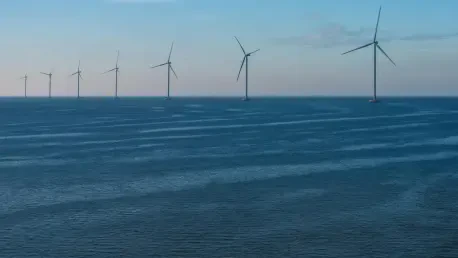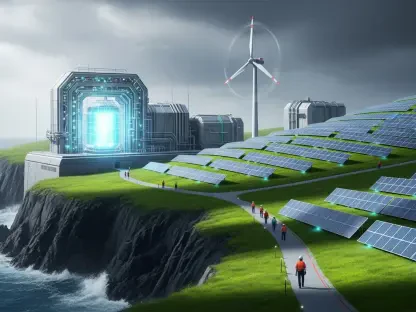In a striking turn of events, the Trump administration has taken decisive action to halt the ambitious Atlantic Shores offshore wind project, positioned just off the coast of Long Beach Island, New Jersey, sparking intense debate over the future of renewable energy in the United States. This initiative, a collaboration between EDF Renewables and Shell, was designed to install up to 197 turbines as close as 8.7 miles from shore, boasting a potential capacity of 2,800 megawatts to power coastal regions. However, fierce opposition from local communities, commercial fishermen, environmental activists, and now federal authorities has cast a shadow over its progress. This clash epitomizes a broader struggle between the urgent push for clean energy and the tangible concerns of those directly impacted by such large-scale developments. As legal battles intensify and political winds shift, the fate of Atlantic Shores has become a focal point in the national conversation about balancing energy innovation with local and security priorities.
Legal Challenges and Federal Intervention
The Trump administration’s recent move to challenge the Atlantic Shores project approvals marks a significant pivot in federal energy policy, reflecting growing skepticism toward offshore wind initiatives. On September 27, the U.S. Justice Department intervened in a lawsuit filed by Save LBI, a coalition of homeowners, businesses, and fishermen from the Jersey Shore area. This legal action, lodged in the U.S. District Court for the District of Columbia, contests the project’s authorization by the Bureau of Ocean Energy Management (BOEM) under the prior administration. Critics argue that the approval process overlooked critical data, underestimated impacts on marine mammals, and ignored potential harm to tourism and local economies. The Justice Department’s motion to remand these approvals suggests a willingness to reevaluate the project’s foundation, highlighting possible legal flaws and setting a precedent for stricter scrutiny of similar ventures across the country.
Beyond the courtroom, the involvement of federal agencies underscores a broader policy shift aimed at curbing renewable energy projects perceived as problematic. Save LBI, under the leadership of President Bob Stern and legal representation by Thomas Stavola Jr., has already achieved a notable victory by securing the suspension of the project’s Clean Air Act permit earlier this year. Their current goal is to dismantle the construction and operations plan entirely, citing inadequate assessment of cumulative effects from multiple offshore wind developments along the coast. This legal push, backed by federal support, illustrates a growing alignment between local opposition and national agendas, raising questions about how future projects can navigate such a hostile regulatory landscape. The outcome of this case could redefine the criteria for approving renewable energy initiatives in sensitive coastal zones.
Local Opposition and National Security Concerns
Local resistance to the Atlantic Shores project has been a driving force behind its precarious status, with communities voicing deep concerns over economic and environmental repercussions. Residents and businesses near Long Beach Island fear that the towering turbines will disrupt the scenic coastline, deter tourists, and diminish property values, which are vital to the region’s economy. Commercial fishermen, meanwhile, worry about restricted access to fishing grounds and potential damage to marine ecosystems, which could jeopardize their livelihoods. These grievances have found a powerful ally in Save LBI, whose advocacy has amplified the voices of those who see offshore wind as an industrialization of their coastal heritage. This groundswell of opposition paints a vivid picture of the tangible stakes for small communities caught in the crosshairs of national energy goals.
Adding another layer of complexity, national security concerns have emerged as a critical argument against the project, further fueling the Trump administration’s stance. Rep. Jeff Van Drew of New Jersey has publicly raised alarms in correspondence with Defense Secretary Pete Hegseth, asserting that offshore wind farms like Atlantic Shores could interfere with radar, sonar, and military training operations. The proximity of such installations to strategic coastal areas is seen as a potential liability during times of conflict, posing navigational hazards and complicating defense strategies. Interior Secretary Doug Burgum has echoed these sentiments, aligning with a broader policy to reassess and often dismantle offshore wind approvals from the previous administration. This intersection of local discontent and national security rhetoric creates a formidable barrier, challenging proponents to address not just environmental but also geopolitical implications of renewable energy expansion.
Economic Struggles and Industry Uncertainty
The Atlantic Shores project also grapples with significant financial and logistical hurdles that threaten its viability, reflecting broader challenges within the offshore wind sector. Economic pressures such as global inflation, supply chain disruptions stemming from the aftermath of the COVID-19 pandemic, and geopolitical tensions like the war in Ukraine have strained the project’s budget and timeline. Shell, one of the key partners, reported a staggering $1 billion write-down on its U.S. offshore wind investments, signaling deep financial distress. Additionally, Atlantic Shores withdrew its initial bid with the New Jersey Board of Public Utilities in June, hoping to resubmit a revised proposal. These setbacks mirror the fate of other ventures, such as Ørsted’s failed Ocean Wind project, highlighting an industry struggling to maintain momentum amid mounting costs and uncertainty.
Despite these difficulties, the demand for renewable energy remains a compelling counterargument, as urban coastal areas and data centers drive an ever-growing need for power. Advocates argue that projects like Atlantic Shores are essential to meeting future energy goals, even as they face economic headwinds. The mixed outcomes of other initiatives, such as the negotiated continuation of Equinor’s Empire Wind and the temporary halt followed by resumption of Ørsted’s Revolution Wind, suggest that compromise is possible in some cases. However, the persistent financial strain raises critical questions about the scalability of offshore wind in the current economic climate. As developers seek innovative solutions to cut costs and secure funding, the industry’s ability to adapt will likely determine whether such projects can withstand both market forces and political opposition in the years ahead.
Path Forward Amid Polarized Perspectives
Looking back, the controversy surrounding Atlantic Shores encapsulates a pivotal moment in U.S. energy policy, where legal, economic, and political forces collide with striking intensity. The Trump administration’s interventions, including stop-work orders and legal challenges, underscore a deliberate effort to reevaluate renewable projects through a lens of caution and local priority. Yet, the partial reversals of shutdowns for certain initiatives reveal that absolute rejection is not always the outcome, hinting at a nuanced battlefield where negotiation plays a role.
Reflecting on this, the next steps for stakeholders involve crafting strategies that bridge the divide between energy innovation and community concerns. Policymakers could prioritize transparent impact assessments and robust community engagement to mitigate opposition. Meanwhile, developers might focus on hybrid models or scaled-down projects to balance economic feasibility with environmental and security considerations. As the debate evolves, fostering dialogue between all parties will be crucial to shaping a sustainable energy future that respects both national needs and local voices.









